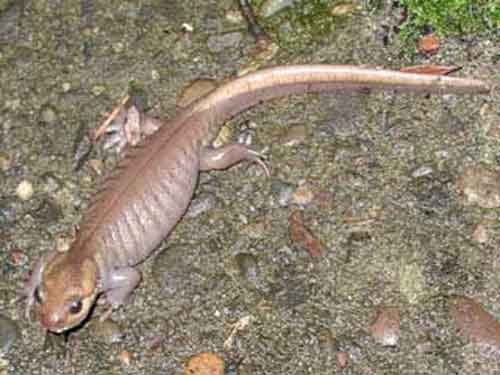
Ambystoma gracile (United States Geological Survey)
Superregnum: Eukaryota
Regnum: Animalia
Subregnum: Eumetazoa
Cladus: Bilateria
Cladus: Nephrozoa
Superphylum: Deuterostomia
Phylum: Chordata
Cladus: Craniata
Subphylum: Vertebrata
Infraphylum: Gnathostomata
Superclassis: Tetrapoda
Classis: Amphibia
Subclassis: Lissamphibia
Ordo: Urodela
Subordo: Salamandroidea
Familia: Ambystomatidae
Genus: Ambystoma
Species: Ambystoma gracile
Name
Ambystoma gracile (Baird, 1859)
Type locality: "Cascade Mountains, near latitude 40° [N.]", Oregon, USA.
Syntypes: USNM 4080 (2 larval specimens).
Synonyms
Siredon gracilis Baird, 1859
Amblystoma paroticum Baird in Cope, 1868
Amblystoma decorticatum Cope, 1886
Chondrotus paroticus — Cope, 1887
Chondrotus decorticatus — Cope, 1887
Ambystoma decorticatum — Stejneger & Barbour, 1917
Ambystoma gracile — Dunn, 1926
Ambystoma gracile gracile — Dunn, 1944
Ambystoma gracile decorticatum — Dunn, 1944
Ambystoma (Ambystoma) gracile — Tihen, 1958
References
Baird, 1859, Rep. Upon Explor Surv. Route Railroad Mississippi-Pacific Ocean, 10(Part 4, No. 4): 13.
Tihen, 1958, Bull. Florida State Mus., Biol. Sci., 3: 3, 39.
Frost, D. 2008. Amphibian Species of the World: an Online Reference. Version 5.2 (15 July, 2008). Electronic Database accessible at www.research.amnh.org/herpetology/amphibia. American Museum of Natural History, New York, USA. Ambystoma gracile
AmphibiaWeb: Information on amphibian biology and conservation. [web application]. 2010. Berkeley, California: Ambystoma gracile. AmphibiaWeb, available at http://amphibiaweb.org/.
2007 IUCN Red List of Threatened Species IUCN: Ambystoma gracile (Least Concern) Downloaded on 26 July 2008.
Vernacular names
English: Northwestern Salamander
The northwestern salamander (Ambystoma gracile) is a species of mole salamander that inhabits the northwest Pacific coast of North America. These fairly large salamanders grow to 8.7 in (220 mm) in length. It is found from southeastern Alaska on May Island, through Washington and Oregon south to the mouth of the Gualala River, Sonoma County, California. It occurs from sea level to the timberline, but not east of the Cascade Divide. Its range includes Vancouver Island in British Columbia and The San Juan Islands, Cypress, Whidbey, Bainbridge, and Vashon Islands in Washington.[2]
Description
The egg mass is very firm, it feels much like a brain with a jelly layer around the entire mass. The individual eggs are 2 mm diameter with the entire egg mass the size of your fist. The egg masses are laid in water about 0.5– 2 meters below the surface.
The hatchlings are 1-35mm long with feathery gills on the side of the body. The juveniles are 16– 105 mm long from their snout to vent. Adults are 40–107 mm long from their snout to vent.
Distribution and habitat
A Northwestern salamander found in Langley, British Columbia
The spotted forms occur in the northern portion of its range.[2][3] A dividing line of 51°N latitude has been recognized between the two subspecies, with A. g. decorticatum occurring north of the line and A. g. gracile living to the south.[2]
Populations with neotenic adults are widespread; the frequency of gilled adults increases with altitude such that adults at low and intermediate altitudes are almost all terrestrial, while adults at very high elevations are mostly neotenic.[4] An example of a paedomorphic population of the northwestern salamander occurs at Crater Lake, Oregon; the population is syntopic with Taricha granulosa.[5]
Terrestrial adults live in mesic habitats ranging from grasslands to mesophytic forests. Terrestrial adults are mostly fossorial, and are usually active on the surface only during fall rains and spring migrations to their aquatic breeding sites. However, they can sometimes be found under logs and other surface debris outside of the breeding season.[3][6]
Adult salamanders eat small terrestrial invertebrates such as insects, worms, and arachnids. Larvae and juveniles consume aquatic invertebrates including snails, worms, and tadpoles.
Conservation
Viable A. gracile egg mass suspended above water as water level dropped.
The conservation status of Ambystoma gracile populations is unknown.[7] No declines are apparent in Canada.[8] In the Cascade Mountains of Washington, A. gracile is far less abundant in young forests than in old-growth forests.[9] However, a survey in western Oregon found little correlation between salamander abundance and stand age, so it remains unclear whether A. gracile requires old growth forest to thrive.[10] Clear-cutting, however, seems to render the habitat unsuitable; no salamanders were found on recent clear-cuts. Leaving a forest buffer of 200–250 m surrounding breeding sites used by terrestrial adults may preserve optimal environmental conditions for local populations.[3]
References
IUCN SSC Amphibian Specialist Group (2015). "Ambystoma gracile". IUCN Red List of Threatened Species. 2015: e.T59057A56458627. doi:10.2305/IUCN.UK.2015-4.RLTS.T59057A56458627.en. Retrieved 12 November 2021.
Snyder, R.C. 1963. Ambystoma gracile. Catalogue of American Amphibians and Reptiles: 1-2.
Petranka, J. W. (1998). Salamanders of the United States and Canada. Smithsonian Institution Press, Washington and London.
Eagleson, G. W. (1976). A comparison of the life histories and growth patterns of populations of the salamander Ambystoma gracile (Baird) from permanent low-altitude and montane lakes. Canadian Journal of Zoology, 54, 2098-2111.
C. Michael Hogan (2008) Rough-skinned Newt (Taricha granulosa), Globaltwitcher, ed. Nicklas Stromberg Archived 2009-05-27 at the Wayback Machine
Efford, I. E. and Mathias, J. A. (1969). "A comparison of two salamander populations in Marion Lake, British Columbia." Copeia, 1969, 723-736.
Blaustein, A. R., Wake, D. B., and Sousa, W. P. (1994). "Amphibian declines: Judging stability, persistence, and susceptibility of populations to local and global extinctions." Conservation Biology, 8(1), 60-71.
Weller, W. and Green, D. M. (1997). Checklist and current status of Canadian amphibians. Amphibians in Decline: Canadian Studies of a Global Problem. D. M. Green, eds., Herpetological Conservation, 309-328.
Aubry, K. B., and Hall, P. A. (1991). Terrestrial amphibian communities in the southern Washington Cascade Range. Wildlife and Vegetation of Unmanaged Douglas-fir Forests, General Technical Report PNW-GTR-285. Ruggiero, L. F., Aubry, K. B., Carey, A. B., and Huff, M. H., technical coordinators, eds., USDA Forest Service, Northwest Research Station, Olympia, Washington., 326-338.
Corn, P. S. and Bury, R. B. (1991). Terrestrial amphibian communities in the Oregon Coast Range. Wildlife and Vegetation of Unmanaged Douglas-fir Forests, General Technical Report PNW-GTR-285. K. Ruggiero, B. Aubry, A. B. Carey, and M. H. Huff, technical coordinators, eds., USDA Forest Service, Pacific Northwest Research Station, Olympia, Washington., 304-317.
Retrieved from "http://en.wikipedia.org/"
All text is available under the terms of the GNU Free Documentation License

